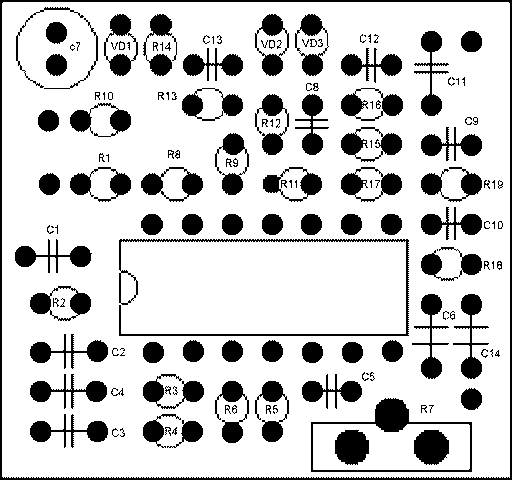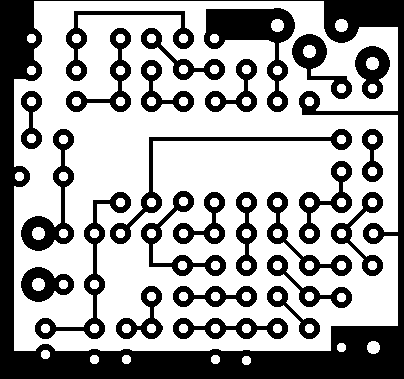
|
|
ENCYCLOPEDIA OF RADIO ELECTRONICS AND ELECTRICAL ENGINEERING Phase limiter of the speech signal. Encyclopedia of radio electronics and electrical engineering
Encyclopedia of radio electronics and electrical engineering / Knots of amateur radio equipment. Signal limiters, compressors To improve communication efficiency, almost all radio stations use methods to compress the dynamic range of the speech signal. But the operation of these devices at industrial production stations does not suit everyone. This is especially true for car stations in the MW range, when operating in FM mode. Basically, these stations have simple limiters, without proper pre- and post-processing of the signal. To reduce a large level of distortion, the signal is filtered early, below 2.5 kHz. All this leads to the loss of a significant part of the frequency information of the signal, and hence to the deterioration of its intelligibility. Practice shows that in most cases, for these stations, the carrier power level should exceed the interference level by 1.5-2 points, otherwise it is difficult to parse the information. And this is 10-15 times in power. A properly executed and adjusted microphone path allows, without violating the norms for deviation and frequency band, to ensure intelligibility almost with the level of interference. This, in turn, allows you to do without amplifiers and effectively use the allowed power. In this regard, most radio amateurs are finalizing their stations. I propose one of the circuit options (Fig. 1) which is simple and implements the principles detailed in the literature [1], [2]. All functional nodes are made on a single K561LN2 chip, consisting of six logic elements. The disadvantage of any limiter is that the stronger frequency components cancel out the weaker ones. In connection with this, special attention should be paid to the formation of the amplitude-frequency characteristic (AFC) of the microphone path. The scheme has great flexibility in the formation of the frequency response and allows, taking into account the characteristics of the microphone, to build it so that all frequency components enter the limitation zone evenly and the speech signal looks natural, loud and intelligible. The microphone amplifier is made on three elements DD1.1-DD1.3, with direct connection. The amplifier stages are covered by the main negative feedback circuit (NFB) R4, R5 and two additional R3, C5. The frequency response is formed by all elements of the amplifier. The amplified and corrected signal, from the limiting level regulator R7, is fed to the first limiter DD1.4. The limited square wave signal is converted by the phase shifter DD1.5, R12, C8 into a triangular waveform by subtracting the odd harmonics. From the divider R13, R14, the signal goes to the next limiter VD2, VD3, where the vertices of the triangle are cut off, and the signal is close to sinusoidal in shape. Next, the signal passes through an active filter with a cutoff frequency of 3 kHz, assembled on DD1.6, with adjacent elements. The printed circuit board is made of one-sided fiberglass, has small dimensions of 3x3 cm and is freely placed inside any station. The arrangement of parts is shown in fig. 2.
Connecting the device is quite simple. The internal path is disconnected from the deviation regulator by soldering the transition capacitance in this circuit and output 3 is connected there. The microphone from the PTT connector is connected to input 1. The wire going inside the station is removed. If the station has other types of modulation, then they do not touch it, and the signal is fed to input 1 through a 2.2 Kom resistor. Point 2 is supplied with power from the point where it appears in the FM transmission mode. The adjustment begins with connecting a sound generator to the input and an oscilloscope to output 3. Set the generator frequency to about 2 kHz, increase the generator output level, bring the circuit to the limit, then, by changing the frequency, check the filter setting. The frequency response should be flat up to 3 kHz, with a slight rise at the end, after which a decline is observed. In case of discrepancy, the selection of R19 sets the frequency, and C11 determines the amount of rise at the end of the characteristic. The amplitude of the output voltage is about 0.8 V. In most stations, with a deviation regulator resistance of 3 kΩ or more and the specified value of R18, the normal deviation level is set near the middle position. Adjust the deviation to the instruments or to the control station by first setting R7 in such a position that the path reaches the limit when talking in front of the microphone. Set the optimal sensitivity from the microphone resistor R7. After that, you can begin to evaluate the quality of the signal. With the indicated ratings, the frequency response is adapted to work with an electret microphone and the sound coloring is closer to natural. You can get a different color at your discretion. By lowering the low-pass cutoff frequency to 2.7 kHz and balancing the components in a narrower band, we get a louder sound of a coherent character. It is enough to increase C5 to 6.8n, pick up R6, C3. You can also use the dynamic microphone used in the stations. If gain is not enough, increase R8. The scheme can be used with the same success for SSB operation, but in this case, a much smaller increase in frequency response is required, for which R 6 must be significantly increased or completely eliminated. Literature: 1. V. Polyakov. Phase limiters of speech signals. Radio No. 3 1980
Author: Shatun Alexander Nikolaevich, Kharkov region, Dergachi; Publication: N. Bolshakov, rf.atnn.ru
Artificial leather for touch emulation
15.04.2024 Petgugu Global cat litter
15.04.2024 The attractiveness of caring men
14.04.2024
▪ SeeDevice PAT-PD image sensors ▪ Helmet for early diagnosis of stroke ▪ Smart payment card BrilliantTS ▪ The new concept of the Internet from AllSeen Alliance
▪ section of the site Household electrical appliances. Selection of articles ▪ article Foreign literature of the XNUMXth century in brief. Crib ▪ article How do oil rigs work? Detailed answer ▪ Article Garlic grass. Legends, cultivation, methods of application ▪ article Photoelectric converters. Encyclopedia of radio electronics and electrical engineering
Home page | Library | Articles | Website map | Site Reviews www.diagram.com.ua |






 Arabic
Arabic Bengali
Bengali Chinese
Chinese English
English French
French German
German Hebrew
Hebrew Hindi
Hindi Italian
Italian Japanese
Japanese Korean
Korean Malay
Malay Polish
Polish Portuguese
Portuguese Spanish
Spanish Turkish
Turkish Ukrainian
Ukrainian Vietnamese
Vietnamese



 Leave your comment on this article:
Leave your comment on this article: